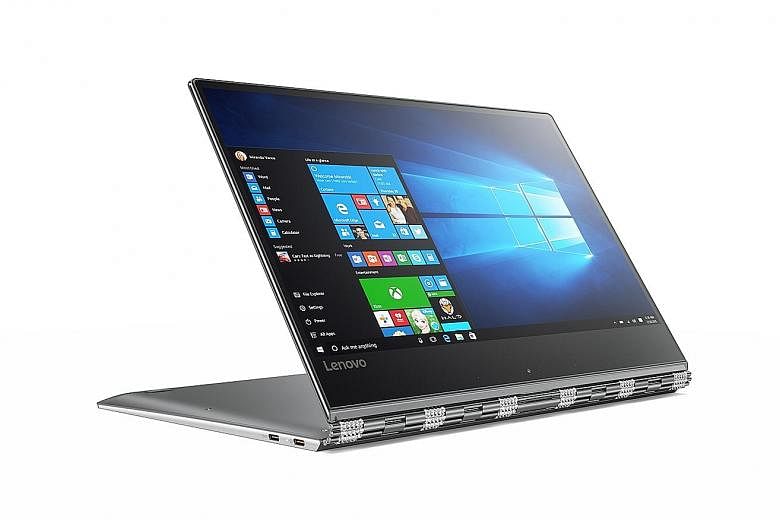I have lost count of the number of Lenovo Yoga devices that I have tested over the past few years.
Common to all these devices, and probably the reason for the Yoga moniker, is the flexible 360-degree hinge that lets these hybrid laptops switch easily between tablet and laptop forms.
Over the years, this hinge has evolved to its current watchband-like form. The latest Yoga 910 sports a similar version, though it seems to offer more resistance than previous iterations.
You won't be able to open the lid one-handed, but the display also seems less wobbly. There is a soft, reassuring click when I close the lid.
Compared with the standard 13.3-inch ultrabooks, the Yoga has a slightly larger screen. Its 1,920 x 1,080 pixels screen resolution is adequate for its size. Viewing angles are wide and colours are vivid.
-
TECH SPECS
-
PRICE: $2,699
PROCESSOR: Intel Core i7-7500U (2.7GHz)
GRAPHICS: Intel HD Graphics 620
RAM: 16GB DDR4
SCREEN SIZE: 13.9 inches, 1,920 x 1,080 pixels
CONNECTIVITY: 1 x USB 3.0 Type-C, 1 x USB 2.0 Type-C, 1 x USB 3.0, audio jack
BATTERY: 78 watt-hour
RATING
FEATURES: 4/5
DESIGN: 4/5
PERFORMANCE: 4/5
VALUE FOR MONEY: 2/5
BATTERY LIFE: 5/5
OVERALL: 4/5
At around 1.4kg, the Yoga is much heavier than previous versions, largely because of its beefy 78 watt-hour battery that is almost twice the capacity of the typical ultrabook battery.
Coupled with the latest Intel Core i7 processor, which is more power-efficient at video playback, the Yoga lasted an incredible 10.5 hours in our video-loop battery test. You'd be lucky to get an uptime over 7hr for a typical ultrabook.
Dell did it first but the Yoga, too, has the Web camera at the bottom bezel of the screen. As a result, Lenovo can shrink the bezel on three sides of the screen, which makes the display stand out more. But the downside is that it may lead to unflattering shots while using the Web camera.
The keyboard lives up to Lenovo's reputation. It is not as shallow as that of some ultrabooks. The Fn keys double as shortcut keys for commands such as volume control and toggling the Wi-Fi adapter. The Microsoft Precision touchpad is smooth to the touch. It supports multi-touch gestures like tapping the touchpad with two fingers to execute a right-click.
Its fingerprint sensor lets you log in quickly to Windows 10 with a touch of your finger. In my testing, it worked very well and was faster than typing in my password.
Like many newer laptops, the Yoga has smaller, reversible USB Type-C ports. But one of its two USB Type-C ports uses the slower USB 2.0 interface because it is intended to be the charging port. The other USB Type-C port supports the 3.0 standard.
None of these ports supports Thunderbolt 3, which seems like an oversight when manufacturers are starting to launch Thunderbolt 3 accessories like docks and monitors.
The good news is that the Yoga still has a full-size USB 3.0 port, though there is no SD card reader.
My $2,699 review set is the highest-available configuration with 16GB of memory and a 1TB solid-state drive. The laptop scored 2,984 in the PCMark 8 Home benchmark, which tests standard computing tasks like Web browsing, compared with 2,786 for the Asus ZenBook 3, which sports similar hardware.
Vincent Chang
• With its watchband-inspired hinge, the Yoga 910 spells classy. Battery life is outstanding, too.


